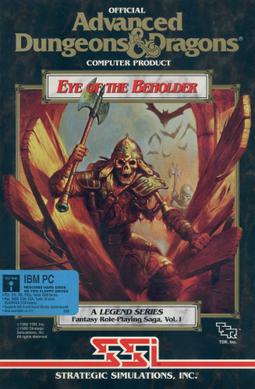
Eye of the Beholder is a role-playing video game for personal computers and video game consoles developed by Westwood Associates. It was published by Strategic Simulations, Inc. in 1991, for the MS-DOS operating system and later ported to the Amiga, the Sega CD and the SNES. The Sega CD version features a soundtrack composed by Yuzo Koshiro and Motohiro Kawashima. A port to the Atari Lynx handheld was developed by NuFX in 1993, but was not released. In 2002, an adaptation of the same name was developed by Pronto Games for the Game Boy Advance.

Curse of the Azure Bonds is a role-playing video game developed and published by Strategic Simulations in 1989. It is the second in a four-part series of Forgotten Realms Advanced Dungeons & Dragons Gold Box games, continuing the events of Pool of Radiance.
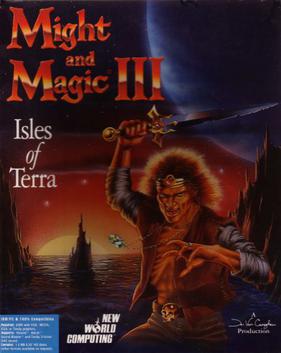
Might and Magic III: Isles of Terra is the third game in the role-playing video game series Might and Magic. Released in 1991, it is the predecessor to Might and Magic IV: Clouds of Xeen and the sequel to Might and Magic II: Gates to Another World. A Sega Genesis version was developed, but never released.

The Bard's Tale II: The Destiny Knight is a fantasy role-playing video game created by Interplay Productions in 1986. It is the first sequel to The Bard's Tale, and the last game of the series that was designed and programmed by Michael Cranford.

Dragon Wars is a fantasy role-playing video game developed by Rebecca Heineman, published by Interplay Productions in 1989, and distributed by Activision.

Secret of the Silver Blades is the third in a four-part series of Forgotten Realms Dungeons & Dragons "Gold Box" adventure role-playing video games. The game was released in 1990.

Buck Rogers: Countdown to Doomsday is a role-playing video game set in the Buck Rogers XXVC universe. It was published in 1990 by Strategic Simulations for MS-DOS, Commodore 64, and Amiga. A Sega Genesis version was released in 1991. Buck Rogers: Matrix Cubed is the 1992 sequel.

J.R.R. Tolkien's The Lord of the Rings, Vol. I is a role-playing video game published by Interplay Productions. It is an adaptation of The Fellowship of the Ring by J. R. R. Tolkien, being the first volume in The Lord of the Rings. The game was released in 1990 for DOS, in 1991 for the Amiga and PC-98, and in 1992 for the FM Towns. It was followed by J.R.R. Tolkien's The Lord of the Rings, Vol. II: The Two Towers. It was originally designed for the Commodore 64, but the production team switched to the newer platforms. The game was designed by Troy A. Miles, Scott Bennie, Jennell Jaquays, and Bruce Schlickbernd. For the later versions, the cutscenes are taken from the 1978 Lord of the Rings film directed by Ralph Bakshi.
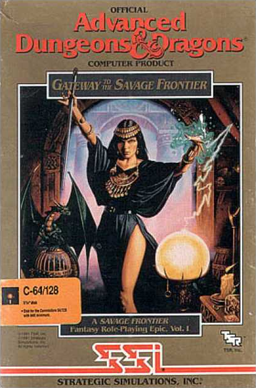
Gateway to the Savage Frontier (1991) is a Gold BoxDungeons & Dragons computer game developed by Beyond Software and published by SSI for the Commodore 64, PC and Amiga personal computers.
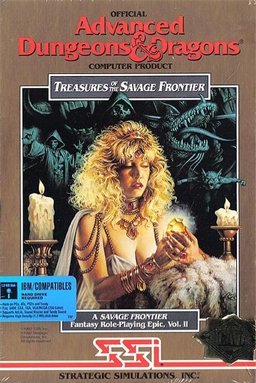
Treasures of the Savage Frontier (1992) is a Gold Box Dungeons & Dragons role-playing video game. It was developed by Beyond Software and published by SSI for the Amiga and DOS.
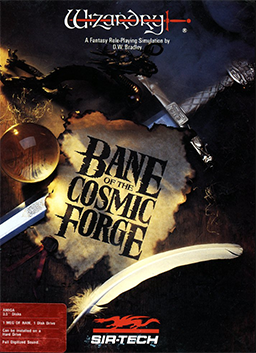
Wizardry VI: Bane of the Cosmic Forge is the 6th title in the Wizardry series of role-playing video games. It was the first in the trilogy surrounding the Dark Savant, which was followed by Wizardry VII: Crusaders of the Dark Savant and Wizardry 8. It was developed by Sir-Tech Software, Inc. and was released on the Amiga and DOS platforms in 1990 by the same company, and for the Super Famicom in Japan in 1995 by ASCII.
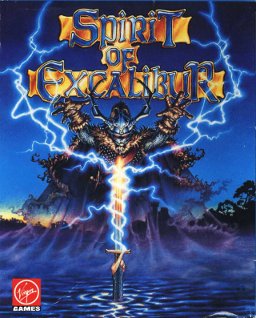
Spirit of Excalibur is a 1990 role-playing game developed by Synergistic Software and published by Virgin Mastertronic for MS-DOS, Amiga, Atari ST, Commodore CDTV, Apple IIGS and Macintosh. The player controls a host of characters with the goal of uniting Sub-Roman Britain under a single king and defending the kingdom. The game was followed by the sequel Vengeance of Excalibur in 1991.

The Immortal is an isometric action-adventure game originally created by Will Harvey and released by Electronic Arts in 1990 for the Apple IIGS. It was soon ported to the Amiga, Atari ST, DOS, Nintendo Entertainment System, and Genesis. A wizard is attempting to find his mentor in a large and dangerous labyrinth. It has a high degree of graphic violence. In 2020, the NES port was re-released on the Nintendo Switch Online service, while the Genesis port was re-released on the Piko Collection Collection 1 cartridge for the Evercade.

Hard Nova is a role-playing video game developed by Malibu Interactive and published by Electronic Arts in 1990 for DOS, Amiga and Atari ST. It is a follow-up to Sentinel Worlds I: Future Magic.

Eye of the Beholder II: The Legend of Darkmoon is a 1991 role-playing video game and the sequel to the first Eye of the Beholder. It used a modified version of the first game's engine, added outdoor areas and greatly increased the amount of interaction the player had with their environment, along with substantially more role-playing aspects to the game. A sequel, Eye of the Beholder III: Assault on Myth Drannor, was released in 1993.

Castles is a video game developed by Quicksilver and published by Interplay Entertainment in 1991 and 1992. The game involves the construction of a series of castles in Wales and the Welsh Marches during the 13th century. Castles was quickly followed by an expansion, Castles: The Northern Campaign, and a sequel, Castles II: Siege and Conquest.

Crusaders of Khazan is a computer adaptation of the tabletop role-playing game Tunnels and Trolls, developed and published by New World Computing in 1990 for DOS, FM Towns, PC-88 and PC-98. The game is available from Flying Buffalo and in Fiery Dragon's Tunnels and Trolls 30th Anniversary Edition. The game was an international production, designed and directed in the US but programmed in Japan.

Elvira II: The Jaws of Cerberus is the second game in the Elvira series of horror adventure/role-playing video games. It was developed by Horror Soft and published by Accolade in 1992. The game is a sequel to 1990's Elvira: Mistress of the Dark. It was followed by Waxworks, which can be considered its spiritual sequel.
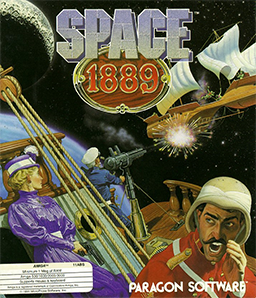
Space: 1889 is an adventure game developed by Paragon Software and published in 1990 for Amiga, Atari ST, and MS-DOS.

Elvira: The Arcade Game is a side-scrolling platform game released in 1991 for the Amiga, Atari ST, Commodore 64, and MS-DOS by Flair Software. The game is loosely based upon the film Elvira: Mistress of the Dark, released in 1988, and she features as the playable character.





















